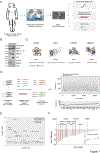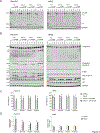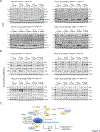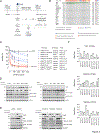Pharmacologic Targeting of TFIIH Suppresses KRAS-Mutant Pancreatic Ductal Adenocarcinoma and Synergizes with TRAIL
- PMID: 35819261
- PMCID: PMC9481717
- DOI: 10.1158/0008-5472.CAN-21-4222
Pharmacologic Targeting of TFIIH Suppresses KRAS-Mutant Pancreatic Ductal Adenocarcinoma and Synergizes with TRAIL
Abstract
Pancreatic ductal adenocarcinoma (PDAC) typically presents as metastatic disease at diagnosis and remains refractory to treatment. Next-generation sequencing efforts have described the genomic landscape, classified molecular subtypes, and confirmed frequent alterations in major driver genes, with coexistent alterations in KRAS and TP53 correlating with the highest metastatic burden and poorest outcomes. However, translating this information to guide therapy remains a challenge. By integrating genomic analysis with an arrayed RNAi druggable genome screen and drug profiling of a KRAS/TP53 mutant PDAC cell line derived from a patient-derived xenograft (PDCL), we identified numerous targetable vulnerabilities that reveal both known and novel functional aspects of pancreatic cancer biology. A dependence on the general transcription and DNA repair factor TFIIH complex, particularly the XPB subunit and the CAK complex (CDK7/CyclinH/MAT1), was identified and further validated utilizing a panel of genomically subtyped KRAS mutant PDCLs. TFIIH function was inhibited with a covalent inhibitor of CDK7/12/13 (THZ1), a CDK7/CDK9 kinase inhibitor (SNS-032), and a covalent inhibitor of XPB (triptolide), which led to disruption of the protein stability of the RNA polymerase II subunit RPB1. Loss of RPB1 following TFIIH inhibition led to downregulation of key transcriptional effectors of KRAS-mutant signaling and negative regulators of apoptosis, including MCL1, XIAP, and CFLAR, initiating caspase-8 dependent apoptosis. All three drugs exhibited synergy in combination with a multivalent TRAIL, effectively reinforcing mitochondrial-mediated apoptosis. These findings present a novel combination therapy, with direct translational implications for current clinical trials on metastatic pancreatic cancer patients. Significance: This study utilizes functional genetic and pharmacological profiling of KRAS-mutant pancreatic adenocarcinoma to identify therapeutic strategies and finds that TFIIH inhibition synergizes with TRAIL to induce apoptosis in KRAS-driven pancreatic cancer.
©2022 American Association for Cancer Research.
Conflict of interest statement
Conflict of Interest Statements: The authors declare no potential conflicts of interest.
Figures





References
-
- Siegel RL, Miller KD, Jemal A. Cancer statistics, 2018. CA Cancer J Clin 2018;68:7–30 - PubMed
-
- Sohn TA, Yeo CJ, Cameron JL, Koniaris L, Kaushal S, Abrams RA, et al. Resected adenocarcinoma of the pancreas-616 patients: results, outcomes, and prognostic indicators. J Gastrointest Surg 2000;4:567–79 - PubMed
-
- Burris HA 3rd, Moore MJ, Andersen J, Green MR, Rothenberg ML, Modiano MR, et al. Improvements in survival and clinical benefit with gemcitabine as first-line therapy for patients with advanced pancreas cancer: a randomized trial. J Clin Oncol 1997;15:2403–13 - PubMed
-
- Conroy T, Desseigne F, Ychou M, Bouche O, Guimbaud R, Becouarn Y, et al. FOLFIRINOX versus gemcitabine for metastatic pancreatic cancer. N Engl J Med 2011;364:1817–25 - PubMed
Publication types
MeSH terms
Substances
Grants and funding
LinkOut - more resources
Full Text Sources
Medical
Research Materials
Miscellaneous

